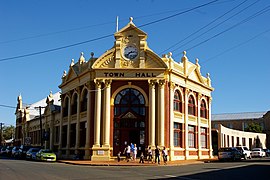| York Western Australia | |||||||||
|---|---|---|---|---|---|---|---|---|---|
 | |||||||||
 | |||||||||
| Coordinates | 31°53′18″S 116°46′07″E / 31.88833°S 116.76861°E | ||||||||
| Population | 2,399 (UCL 2021)[1] | ||||||||
| Established | 1835[2][3] | ||||||||
| Postcode(s) | 6302 | ||||||||
| Elevation | 179 m (587 ft) | ||||||||
| Area | 17.6 km2 (6.8 sq mi) | ||||||||
| Location | 96 km (60 mi) E of Perth | ||||||||
| LGA(s) | Shire of York | ||||||||
| State electorate(s) | Central Wheatbelt | ||||||||
| Federal division(s) | Pearce | ||||||||
| |||||||||
York is the oldest inland town in Western Australia, situated on the Avon River, 97 kilometres (60 mi) east of Perth in the Wheatbelt, on Ballardong Nyoongar land,[4] and is the seat of the Shire of York.
The name of the region was suggested by JS Clarkson during an expedition in October 1830 because of its similarity to his own county in England, Yorkshire.[5]: 22 [a]
After thousands of years of occupation by Ballardong Nyoongar people, the area was first settled by Europeans in 1831, two years after Perth was settled in 1829. A town was established in 1835 with the release of town allotments and the first buildings were erected in 1836.
The region was important throughout the 19th century for sheep and grain farming, sandalwood, cattle, goats, pigs and horse breeding.[7]
York boomed during the gold rush as it was one of the last rail stops before the walk to the goldfields.[8]
Today, the town attracts tourists for its beauty, history, buildings, festivals and art.
- ^ Australian Bureau of Statistics (28 June 2022). "York (urban centre and locality)". Australian Census 2021.
- ^ "Government Notice". The Perth Gazette and Western Australian Journal. 11 July 1835. p. 526. Retrieved 22 January 2016.
- ^ "Perth Surrounds". State Heritage Office. Government of Western Australia. 10 June 2013. Retrieved 22 January 2016.
- ^ King, A and Parker, E: York, Western Australia's first inland town, Parker Print, 2003 p.3.
- ^ John E Deacon: A Survey of the Historical Development of the Avon Valley with Particular Reference to York, Western Australia During the Years 1830-1850, UWA, 1948.
- ^ Taylor, Thomas George (1860). Western Australia; its history, progress, position, & prospects, Volume 13. London: G.Street. p. 10. Retrieved 26 January 2016.
- ^ King, A and Parker, E: York, Western Australia's first inland town, Parker Print, 2003 pp.4-5.
- ^ York WA Heritage Walk Trails, York Visitor Centre, Shire of York (undated) p.29.
Cite error: There are <ref group=lower-alpha> tags or {{efn}} templates on this page, but the references will not show without a {{reflist|group=lower-alpha}} template or {{notelist}} template (see the help page).
